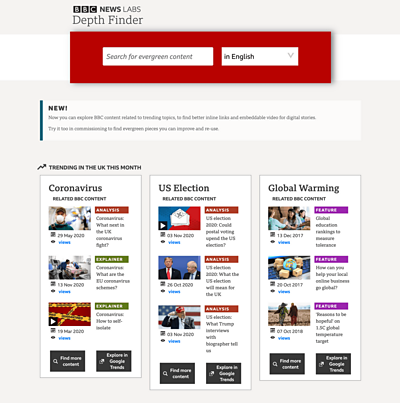Aims
How might we leverage existing ���˿��� content in response to current trends?
Outline
With so much content produced by the ���˿���, we wanted to see whether it was possible to match previously published journalism with the latest news events and trends.
We partially addressed this years ago by creating Depth Finder — a tool that retrieves evergreen content related to a journalist's search term.
In this iteration, we wanted to see whether Depth Finder could automatically surface useful content based on stories trending around the UK.

We spoke to many folks working in editorial roles at the ���˿���, but focused our attention on the SEO team who write a daily email to editorial staff laying out what's trending, and whether we have any pre-existing coverage. They focus specifically on Google Trends as a source of information.
In addition to writing the daily trending newsletter, this team also respond to specific requests from journalists, looking to find specific angles for their beats. For example, a technology reporter might write to ask what questions audiences are asking about the new games console release — and the best search-friendly keywords to use in their headline.
What we learnt
There are a range of options
There is an alphabet soup of different trending tools. Some focus on search data, others on social data. Our biggest learning from our audit is that there is no standard, probably because no one tool fits perfectly into the comfort zone and workflow of all our journalists.
Google trends has its limitations
Although a valuable tool, Google Trends also displays a lot of noise — trends that may not be newsworthy or related to a journalist's particular beat. The SEO team helps filter this out.
Some journalists also feel overwhelmed by the Google Trends interface, or unsure of how to access the information they need.
Timing matters
One significant limitation we found is that the daily search trend emails come out at a set time each day, and new trends surface all the time. For journalists working a night shift, for example, the trends email is many hours old, and may contain out-of-date insights. We decided that if we could make a tool that displays real-time trends, we could improve on the current workflow.
What we built
We focussed out attention on improving Depth Finder and introducing Google trends.
Step One: Depth Finder improvements
We've been aware that Depth Finder hasn't seemed to develop a loyal user base in the way that other tools, such as Stitch and Audiogram, have. Was this because the results weren't useful?
We wanted to establish whether ���˿��� journalists found its existing functionality useful or not.
In order to test this, we made search results shareable, exposing filters like time and language in the url. We had user feedback sessions with journalists and as a result, made improvements to the user interface. We added the ability to filter results by section, and now show the number of views a story has.
Step Two: Matching old news to new trends
We wanted to test whether adding Google Trends to Depth Finder helped journalists find breaking news. We used the Google Trends API to fetch the top nine trending terms in the UK, and made queries to our Elastic Search database to retrieve the "depthy-est" results for each.

We also decided to automatically fetch the highest-ranked video for each of the search terms, to promote the redeployment of video content, which is time intensive to produce.
What we didn't want to build is an interface onto Google Trends. Instead we chose to link out to the Google Trends dashboard for each trending term. We hoped to demystify this data and give journalists a jumping point for discovering other useful insights.
For example, knowing "Boris Johnson" is trending is vaguely useful, but being able to dig into the actual questions that the public are searching for is far more likely to yield something useful - from both content and SEO perspectives.
Next steps
- We're currently adding analytics to our homepage trending cards, to see whether journalists are interested in engaging with them.
- We'll be running a pilot to see whether our Depth Finder improvements are useful to journalists.
Results
- We are monitoring analytics to determine how we might make this tool more useful for journalists








